What Is a Broken Economy, What Are the Unfavorable Economic Policies In a Broken Economy, and the Problems With the Economy Being a Broken Economy
audiobook (Unabridged)
By Dr. Harrison Sachs

Sign up to save your library
With an OverDrive account, you can save your favorite libraries for at-a-glance information about availability. Find out more about OverDrive accounts.
Find this title in Libby, the library reading app by OverDrive.



Search for a digital library with this title
Title found at these libraries:
| Library Name | Distance |
|---|---|
| Loading... |
This audiobook is narrated by a digital voice.
This essay sheds light on what is a broken economy, explicates what are the unfavorable economic policies in a broken economy, and demystifies the problems with the economy being a broken economy. A broken economy is an economy that is replete with unfavorable economic policies. A broken economy is an economy that is also devoid of favorable economic policies. The pervasive presence of unfavorable economic policies in an economy can elicit a broken economy that is characterized by precariousness. Unfavorable economic policies are apart of the underpinnings of a broken economy. The implementation of an exorbitant amount of unfavorable economic policies in an economy can adversely affect an economy and can render an economy at a higher probability to become a broken economy. A broken economy is an economy that is at a high probability to experience an economic decline. Furthermore, a broken economy is an economy that is also at a high probability to experience a gross national product decline. Moreover, a broken economy is an economy that is also at a high probability to experience a contraction in the size of its real private sector workforce. A broken economy is also an inflationary economy. One cause behind the occurrence of inflation in a broken economy is attributable to there being massive pent-up customer demand for products at their retail prices that are not produced in sizeable enough quantities to satisfy pent-up customer demand for them at their retail prices. Aggregate customer demand for products can put an upward pressure on the prices of the products that are in high demand and short supply. If there is massive pent-up customer demand for products at their retail prices that are not produced in sizeable enough quantities to satisfy pent-up customer demand for them at their retail prices, then companies may be all the more inclined to raise the prices of their products in order to further amplify their profit margin per product sold.







